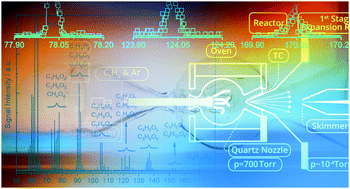Identification of the Criegee intermediate reaction network in ethylene ozonolysis: impact on energy conversion strategies and atmospheric chemistry†
Abstract
The reaction network of the simplest Criegee intermediate (CI) CH2OO has been studied experimentally during the ozonolysis of ethylene. The results provide valuable information about plasma- and ozone-assisted combustion processes and atmospheric aerosol formation. A network of CI reactions was identified, which can be described best by the sequential addition of CI with ethylene, water, formic acid, and other molecules containing hydroxy, aldehyde, and hydroperoxy functional groups. Species resulting from as many as four sequential CI addition reactions were observed, and these species are highly oxygenated oligomers that are known components of secondary organic aerosols in the atmosphere. Insights into these reaction pathways were obtained from a near-atmospheric pressure jet-stirred reactor coupled to a high-resolution molecular-beam mass spectrometer. The mass spectrometer employs single-photon ionization with synchrotron-generated, tunable vacuum-ultraviolet radiation to minimize fragmentation via near-threshold ionization and to observe mass-selected photoionization efficiency (PIE) curves. Species identification is supported by comparison of the mass-selected, experimentally observed photo-ionization thresholds with theoretical calculations for the ionization energies. A variety of multi-functional peroxide species are identified, including hydroxymethyl hydroperoxide (HOCH2OOH), hydroperoxymethyl formate (HOOCH2OCHO), methoxymethyl hydroperoxide (CH3OCH2OOH), ethoxymethyl hydroperoxide (C2H5OCH2OOH), 2-hydroxyethyl hydroperoxide (HOC2H4OOH), dihydroperoxy methane (HOOCH2OOH), and 1-hydroperoxypropan-2-one [CH3C(![[double bond, length as m-dash]](https://www.rsc.org/images/entities/char_e001.gif) O)CH2OOH]. A semi-quantitative analysis of the signal intensities as a function of successive CI additions and temperature provides mechanistic insights and valuable information for future modeling work of the associated energy conversion processes and atmospheric chemistry. This work provides further evidence that the CI is a key intermediate in the formation of oligomeric species via the formation of hydroperoxides.
O)CH2OOH]. A semi-quantitative analysis of the signal intensities as a function of successive CI additions and temperature provides mechanistic insights and valuable information for future modeling work of the associated energy conversion processes and atmospheric chemistry. This work provides further evidence that the CI is a key intermediate in the formation of oligomeric species via the formation of hydroperoxides.

- This article is part of the themed collection: 2019 PCCP HOT Articles


 Please wait while we load your content...
Please wait while we load your content...